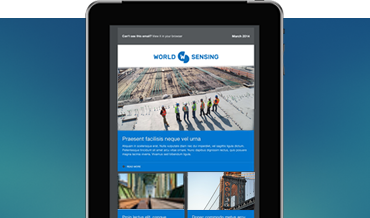3 ways that infrastructure monitoring can help in reducing carbon emissions
The world is focused on halting carbon emissions as Glasgow this week hosts the 26th United Nations (UN) Climate Change conference of parties (COP26). The challenge is daunting, with UN research last month revealing that even the latest decarbonization commitments from around the world will not prevent catastrophic global warming. Can infrastructure monitoring play a role, however minor? We believe so, in three ways.
Extending the lifespan of infrastructure
The point of COP26 is for countries to commit to reducing greenhouse gas emissions, but in practice climate change mitigation will also require changes to the way we treat infrastructure. Cement, the primary ingredient in concrete, is responsible for up to 8% of global carbon emissions, contributing more to climate change than any country other than China, the US or India. Clearly, achieving global climate goals will require changes to the way cement is produced.
But in the short term, the easiest way to cut cement-related emissions is simply not to build so much—which implies keeping existing structures up for longer. Every time a structure collapses or is torn down, it forces us to create more emissions through activities such as demolition, transportation and reconstruction. And the emissions do not just come from cement but also from other materials and in the process of construction itself. In this respect, improved monitoring can help extend the lifespan of structures by allowing faults to be detected in time.
Each structural problem that is repaired in a timely fashion not only helps to improve safety but also reduces the production of greenhouse gas emissions.
Improving the resilience of critical structures
While COP26 debate is rightly concerned with keeping global warming to manageable levels, there is also growing awareness that some temperature rise will be inevitable—and this is already having an impact on our climate. Worsening storms, flooding and other catastrophic climate events are becoming more commonplace, and are often disproportionately affecting populations with the least capacity to withstand them.
For this reason, COP26 conversations include how to urgently protect communities and natural habitats at risk from climate change. Over time, we will see an increasing need to monitor the integrity of key infrastructures such as dams, flood defenses, river embankments and so on. Long-range, low-power wireless monitoring is the most efficient and cost-effective way to achieve this. And it reduces monitoring-related emissions by largely doing away with the need for site visits.
Checking on the integrity of carbon sinks
We have now put so much carbon into the atmosphere that simply halting further emissions will not be enough to stop climate change. Instead, most carbon-neutral pathways now envisage reducing atmospheric CO2, for example through reforestation or a process called carbon capture and storage (CCS). In CCS, carbon is captured from industrial processes or directly from the air and then stored underground.
CCS is expected to play a significant role in decarbonization, with Norway planning to put away 1.5 million tonnes of carbon a year at its Northern Lights scheme and the Netherlands aiming for 2.5 million tonnes with the Port of Rotterdam CO₂ Transport Hub and Offshore Storage project. But for these projects to be successful, it is important that the subsurface carbon storage facilities, which are often in old oil and gas reservoirs, are fit for purpose. And to achieve this, accurate monitoring will be key.
At Worldsensing we already have experience in this area after teaming up with Class VI Solutions, of Oakland, California, to install downhole monitoring equipment in an injection well for the geological storage of CO₂ at a project in Hontomín, Spain.
A small but significant contribution to climate resilience
The climate emergency is demonstrating the need to change our consumption models in the direction of a circular economy, where environmental and social impacts are fully accounted for and considerations such as longevity and efficiency are brought to the fore. Technology is already helping to achieve this shift in some areas, and within the field of critical infrastructures, it is clear remote monitoring can play a small but significant role in reducing materials use, human effort and emissions.
At Wordsensing, we are committed to achieving the UN’s Sustainable Development Goals, and particularly objective 9: to build resilient infrastructure, promote inclusive and sustainable industrialization and foster innovation. Especially over the last five years, different teams at Worldsensing have been working to enhance the sustainability of wireless monitoring solutions through projects such as Harvestore and Greenedge. To find out more about how remote wireless monitoring technology could play a part in your sustainability strategy, speak to us now.

